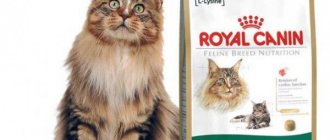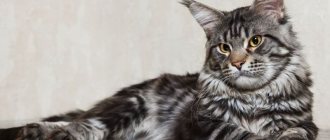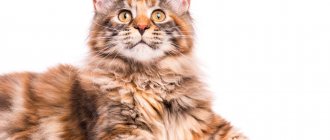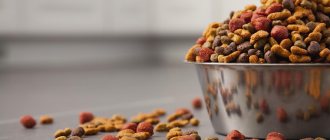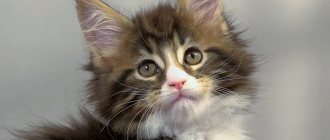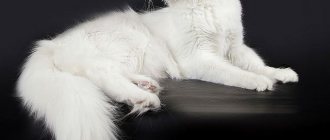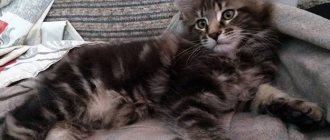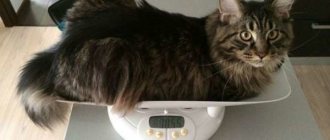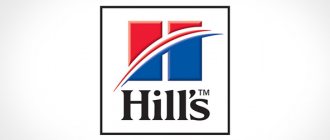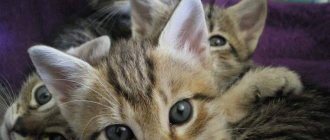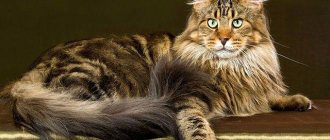Maine Coon domestic cats are spoken of only in superlatives. They are the largest, heaviest, longest, most affectionate, laziest, and also the oldest in the United States.
The pedigree of Maine Coons causes some controversy, but only in terms of how the ancestors of these giant cats came to the American continent.
And their subsequent migration to Europe and the division of the breed into two branches - the indigenous American and the new European - remain in the sphere of interests only of true connoisseurs and professional experts.
What are Maine Coons: types of breed
Despite the fact that the first Maine Coons appeared in the United States, European breeders took part in the development of the breed. Thus, certain breed characteristics inherent in modern representatives were fixed. This was the reason for the appearance of two types of Maine Coons: American and European. Representatives of these subspecies differ from each other in breed characteristics and character. What types of Maine Coons are there, read below.
Description of the American type breed standard
There is an opinion that the Maine Coon is a hybrid of the Manx raccoon and a domestic cat. Genetically this is unlikely, but cats have some similarities with wild raccoons.
The main breed characteristics of the American Maine Coon type:
- Long body and large bones;
- Wide variety of colors. Only chocolate, ticked and point colors are prohibited for breeding, which may indicate interbreeding;
- Thick fur in the collar and panties area. Nature invented this feature to protect cats from the harsh North American climate;
- Fluffy and long tail.
Aboriginal representatives of the breed are distinguished by good health.
Description of American type standard:
- Body: large, rectangular with a wide chest;
- Paws: medium length, round, muscular;
- Tail: long, wide at the base, tapering towards the tip;
- Coat: thick, long, close to the body, waterproof;
- Eyes: wide-set, slanted. The color should look harmonious with the color;
- Head: massive, square. The skull is powerful, the cheekbones are high. The chin, nose and upper jaw form one line;
- Ears: Large, with a wide base, tapering to the tips. The distance between the ears is equal to the width of the base of one ear. A characteristic feature is the presence of tassels;
History of selection and features of the European cat variety
European breeders decided to create an “extreme” breed of cats, based on aboriginal cats. But, despite the efforts of breeders, the European type of Maine Coon has its own mutations, due to which these cats differ from the classical standards.
Description of Maine Coon
These incredibly beautiful cats received the title “Main Coon” due to their large size and similarity to predators.
Kinds
When choosing a Maine Coon kitten, you should take into account that there are 2 types of Coon varieties:
- American
- European
American Maine Coon
A large, broad-boned and squat animal. The head of the American Maine Coon is normal, without any outstanding features.
American type Maine Coon
Maine Coon European type
European Maine Coon
The body of European Maine Coons is long and proportional. The muzzle of such a cat is slightly elongated and has a well-developed box. Even from birth, European kittens have tufts on the tips of their ears, making them look like a domestic lynx.
Size
A distinctive feature of Maine Coons is their continuous growth. These animals grow from 3 to 5 years. With a weight of about 7−12 kg, the total size of an adult cat can reach 1 m! The height at the withers usually reaches 33 cm.
Maine Coon weight by month
You can measure a raccoon cat using any measuring device by placing one end to the nose and the other to the tip of the tail.
wcf breed standards
- Body: long and muscular
- Head: large and massive, with sharp outlines
- Ears: large, wide at the base, with protruding brushes of hair and tassels at the tips
- Tail: long, soft and voluminous
- Coat: 10 to 15 cm, short on the shoulders and head, but longer on the back, along the sides and on the belly
- Eyes: round, straight set, green and yellow shades
| Size | about 1 meter |
| Weight | 7 - 12 kg. |
| Lifespan | 12–16 years old |
Types of colors
Manx coon cats come in a wide variety of colors other than chocolate, brown and lilac. Very often you can find colors with patterns called tabby. Tabby colors are characterized by various fine lines on the face that line the eyes and form the letter "M" on the forehead.
Maine Coon - white solid
Maine Coon - Red Solid
Maine Coon - black solid Solid Maine Coons are a rare phenomenon, which is why they are also called solid or solid. In addition, tortoiseshell, smoky or smoke colors (blue or black with white roots), as well as white markings in various places, are acceptable. Mackerel tabby (striped tabby) Classic tabby (marbled tabby) Spotted tabby (spotted tabby)
Recognized colors
- Mackerel tabby (striped (brindle) tabby) - vertical stripes on the body and spots on the stomach
- Classic tabby (marble tabby) - spiral stripes on the sides, reminiscent of marble stains
- Spotted tabby (spotted tabby) - intermittent stripes throughout the body
Disadvantages and disqualification
In order to participate in exhibitions, the appearance of an American raccoon cat must meet all the requirements for cats of this breed.
The main disadvantages of the Maine Coon and the reasons for disqualification in competitions include:
- Poorly developed torso. The cat's body should be of impressive size, muscular, with a broad chest and strong bones.
- Cloudy eyes. The look of a Maine Coon animal should be clear and predatory.
- Ears set far apart. The Maine Coon's ears should be positioned at the same distance as the base of one of them.
- Short tail. It should be equal to the length of the entire body
- The coat is the same length all over the body
In addition, you should also remember that there are rules for exhibitions, which must indicate possible general reasons for the disqualification of cats.
Historical facts. . . The first mention in literature of the Manx raccoon cat was in 1861. However, this breed was officially recognized only in 1979, that is, only 118 years after its actual participation in exhibitions.
How the breed appeared
The Maine Coon breed is considered indigenous. It got its name in honor of its homeland - Maine. The breed began to form 2 centuries ago. Its first representative was shown in 1861 at exhibitions in Boston and New York.
For a long time, Maine Coons were inferior in popularity to exotic Siamese, Persian and Oriental cats. They looked like wild forest animals, and the breed did not arouse much interest. Maine Coons managed to survive thanks to farmers who preserved their phenotype.
Over time, they regained popularity. They began to be actively exported to other countries and demonstrated at exhibitions. In the second half of the twentieth century. Maine Coons found their way to different European countries. In France, the first Maine appeared in 1981, and in Russia - in 1989. The standard was adopted in 1967, but the breed was first registered in 1908 in the CFA felinological federation.
Today Maine Coons are at the peak of their popularity. There are many nurseries breeding them; new breed types appear. But the main tasks for felinologists are to preserve the integrity of the breed and improve it in accordance with modern tastes.
Animal diseases
A kitten getting sick immediately after moving to a new home is unpleasant and painful. Of course, it is almost impossible to reduce the risk of disease to zero, since moving is stressful for an animal, especially if there are other animals in the house.
- When choosing a Maine Coon kitten, check it yourself for the absence of diseases.
- The kittens' place of residence must be clean.
- Too many cats should not live in the house.
- If the breeder's house or apartment is dirty and unkempt, you should not buy a kitten. It is possible that before the arrival of clients, the owners tried to restore order, and if upon inspection everything looks untidy, then usually everything is much worse.
- The Maine Coon's coat should be fluffy, smooth, shiny and silky. Greasy and dull fur is a sign of a possible illness, and this also applies to other cats in the cattery, and not just the selected kitten.
- Nasal discharge, sneezing, coughing are symptoms of rhinotracheitis. You should not buy a sick animal.
You can determine whether a kitten is healthy or not based on various signs. However, the most important things remain activity, cleanliness, grooming, cheerfulness and energy of the animal.
Animal character
The harsh appearance of Maine Coon cats in the photo differs from their character. In reality, the animals are peaceful and sociable. Maine Coons are more similar in character and habits to dogs than to felines. They love the company of other animals and try to spend time in the company of their owner. Maine Coon and children will become best friends: these cats are affectionate and patient. They will never let out their claws, even if the child does something unpleasant to the pet.
In addition, cats of this breed are distinguished by their resourcefulness, quick intelligence and phenomenal memory. They are easy to train and learn commands: fetch things, open doors, stand on their hind legs. Maine Coons are able to pick up on the intonation in their owner’s voice and quickly adapt to house rules.
Another plus is the breed’s hunting instinct. Even if there are no mice or other living creatures in the house, they will gladly “enter into battle” with socks or toys.
The Maine Coon cat breed is an active animal and their body requires regular exercise. The owners walk their pets 3-4 times a week on a leash. Cats happily walk in any weather and do not run away or hide in trees.
Breeding Maine Coon Cats
Breeding purebred cats is considered a profitable and highly paid occupation. The Maine Coon is one of the 10 most expensive cats in the world. To obtain permission to breed, the cat must take part in the exhibition at least 3 times.
Krasnodar WCF Club “PERSONA-cat” “PERSONA-show-IX”
Documentation
To participate in the exhibition and obtain permission to breed Maine Coon cats, the following documents are required:
- Contract of sale
- Kitten birth metric
- Pedigree
You can sell kittens without a pedigree and a metric only at a significantly reduced price to cat lovers who are not interested in breeding Maine Coons.
How to buy
You can buy a Maine Coon in any nursery in the world, as it is a fairly popular breed. At the same time, it is not at all necessary to go to another city - they can bring it and deliver it personally.
Age
It is recommended to buy a Maine Coon kitten that is 3-3.5 months old. There are several reasons why it is better to take an older animal:
Time for vaccination
In the first three months of life, the kitten receives several vaccinations, which cannot be completed before this period. Buying an animal at a younger age means giving it all the necessary vaccinations yourself.
Feeding period
It is advisable for the kitten to feed on its mother's milk until it is two months old.
Mental development of the baby
During the first three months, the kitten socially adapts and learns. During this time, he adopts the necessary habits from his parents, gets used to people and learns about the world around him. If there is a sharp break with his mother and siblings, irreparable harm can be caused to his psyche.
This is interesting: The character of a Maine Coon cat
External features of an American
Maine Coons from the USA have a number of features unique to the American breed:
- The muzzle is elongated with raised cheekbones and high-set ears. Thanks to long vibrissae, pets are well oriented in the dark.
- Large body with wide bones. Externally, cats do not look stocky and squat, because they have an elongated body. The muscles are well developed.
- They have a movable tail covered with long flowing hair that helps retain heat.
- The hair on the neck and head is short. On the chest and back the hair is longer and thicker. It has weak hydrophobic properties, but they are enough to prevent the animal from getting wet in the snow or drizzling rain.
There are many Maine Coon colors, but they all have breed-specific stripes—smooth or rounded lines with a slightly darker shade of fur. The exception is purple and rich dark brown individuals. Solid colored Maine Coons are extremely rare. Their color is considered a genetic mutation.
Differences from the European breed
If you compare both species, you can see that the European Maine Coon has a more elongated shape. The length of its body, tail, muzzle and paws is greater than that of the American type. European cats are characterized by:
- Lynx tassels on high-set ears. There are tufts of fluff between the toes on the narrow paws.
- Long flexible body covered with short fur. Particularly popular are smoky coat colors, which are not found in the American breed.
- Narrowed, slanted eyes located under a low forehead. They are set wide apart.
- Strong strong-willed chin.
Despite the predatory features of appearance, the European species also has a soft, friendly character. These cats get along well with people, but do not require constant affection.
The character of the “American” and the “European”
Maine Coons are cats and dogs. Unlike other breeds, they love to spend time with their owner, bathe, and carry objects in their teeth.
Representatives of both branches, despite their attachment to the owner, value their independence. They love affection, but cannot stand intrusiveness. Constant squeezing is not for them. When guests come to the house, these cats can play, but they will not get into your hands.
Coons are quite active cats. They love to run and jump, so they require a separate play area in the house. Peak activity is morning and evening. They spend the day on the couch. American representatives of the breed love to play with balls and toy mice, as they are hunters by nature. “Europeans” love to lie on the sofa and have their tummy scratched.
Documentation
The seller of the kitten must provide the buyer with a number of documents:
- parents' pedigrees;
- if the parents have titles, their documentary evidence;
- rules for the care and maintenance of animals;
- pedigree of the purchased kitten;
- veterinary passport with vaccinations;
- a purchase and sale agreement drawn up according to the rules of felinological systems.
If at least one of the listed documents is missing, it is better to refuse the purchase.
After completing the formal part of the purchase, do not forget to ask the breeder about the individual habits of the kitten. This will help in the process of getting to know your pet. In addition, it is worth finding out what kind of food the kitten ate in the house where you are taking it from. It would not be superfluous to clarify the brand of litter for the tray that the former owner uses.
Aborigines
These coons have strong and well-built bones, well-developed muscles, and a massive skull. They are shorter than their relatives from another continent, but are not inferior in strength and endurance. The head of coons from most US catteries is wide, the transition from the convex forehead to the muzzle is noticeable. The eyes are round and of standard size, and the look is friendly.
By nature, the Maine Coon is capable of performing a large number of functions. Therefore, it does not have exaggerated features that can interfere with hunting mice, running away from danger, etc. Color is also important. The American type is characterized by a rich color with a clearer tabby pattern. The wool is usually very thick, heavy, and feels like natural silk.
Additionally for Aboriginal Coons:
- wide set of ears.
- no lush tassels like a lynx
- the ears are slightly shorter than those of relatives from Europe.
For an ordinary person who does not understand cat breeds, a Maine Coon of this type from a distance will look like a Norwegian Forest or Siberian breed. A specialist will immediately identify visible differences. This type has its followers. They try to breed coons with a similar appearance, while maintaining purebredness. Most enthusiasts live in the USA and own nurseries.
Useful to read: Maine Coon - description of the breed
Differences
Fans of the American Maine Coon type make every effort to preserve the natural qualities of the breed, while adherents of the “Europeans” strive to change the features of the traditional appearance of these cats and finally consolidate these changes.
The main differences between European-type cats and Aboriginal cats:
- longer body;
- elongated, almost triangular muzzle;
- oval, set far apart eyes;
- large, high-set ears, decorated with lush tassels;
- less voluminous coat, lack of a thick mane and lush “pants” on the paws;
- The color is most often a solid smoky color rather than a patterned tabby or agouti.
One look at the representatives of the European type makes it clear that these cats are decorative pets, reminiscent of a lynx, and not hunters - rat catchers, like the American Maine Coons.
Varieties of coat colors
For the Maine Coon's long coat, all colors typical of native breed cats are acceptable. Chocolate and lavender shades are prohibited, and Siamese color point and ticked hair are a valid reason for exhibition and breeding disqualification of representatives of the Maine Coon breed in many international felinological organizations.
There are three main characteristics considered in the color of cats: color, pattern and spots.
- All Maine Coons have a tabby pattern - stripes on their coat. They can appear in the form of a “wild” tiger pattern or softer marble stains.
- A group of solid colors (solid) - black, red, blue, cream and white.
- Tortoiseshell spots - a combination of black and red (torbi) or with the addition of light cream, beige (torti).
- Silver and smoke - from simple to very rare chinchilla colors, in which only 1/8 of the hair has pigmentation at the tip.
- White spotted: with buttons, medallions, mittens and socks, bicolors, particolors, harlequins and vans. Each type of Maine Coon has a certain amount of white and colored fur.
- A random combination of all colors is a very common color for Maine Coon cats.
Important! Newborn Maine Coon kittens can wear a “baby” coat until they are six months old, but later, when the animal reaches puberty, it changes color.
The big Manx cat breed is traditionally among the top three most popular on the American continent, although its popularity has long crossed all regional boundaries.
In Europe, the Maine Coon group is the second largest, and the largest representative of this breed lives in Australia. Affectionate and sociable cats are great for families with children or around other pets.
They are sociable, quickly become attached to people and do not cause much trouble in daily maintenance and feeding. The ideal cat, whose enormous size is in harmony with her equally infinite kindness.
Liked? Please rate the article!
You might be interested
Who to choose Russian Blue cat or cat
How a Maine Coon cat gives birth for the first time
Truths and myths about Maine Coon allergies
Guarantee of successful mating of Maine Coons: basic rules
How to choose a kitten?
Small Maine Coon kittens must have the characteristics of the breed - a powerful body structure, erect ears with tassels, a characteristic muzzle shape. It is not desirable for kittens to be clearly smooth-haired. A small cat of the pet class is intended for home keeping. It has a mixture of external inconsistencies with the standard. The babies of the breed class have an elite cat pedigree and breed characteristics that are interesting for breeders. A show class cat is considered a show cat because it has all the features that the Maine Coon breed has. A healthy kitten is playful, with a lively look, clean fur, and no discharge from the eyes and nose. Adulthood in such animals occurs late, around 3-5 years.
Nutrition of raccoon cats
Natural nutrition includes the following set of products:
- chicken, rabbit, beef, turkey
- kefir, sour cream, yogurt without additives
- any vegetables
- boiled or raw chicken eggs
- boiled seafood
Diet of Maine Coon cats
| Adult cat | 2 times a day/300 grams |
| Kittens | 5 times a day/150-200 grams |
Maine Coons should never be given raw fish. Seafood can only be given boiled or steamed, no more than once a week.
You will find more information about what to feed a Maine Coon, feeding rates, daily diet, etc. here
It is extremely undesirable to give fish in any form to a castrated or sterilized cat, as it can serve as a provocateur.
Important! Feeding sweet, fried, spicy, baked foods can have a very bad effect on your cat's health.
If you want to feed your Manx raccoon cat food, then you need to select dry food very carefully. The food must be of high quality, super premium, for example royal canin maine coon. In this case, you should not mix regular food with feed.
The Maine Coon breed will not leave any cat lover indifferent. The owners of these charming pet lynxes mostly leave only positive reviews. Therefore, if you want a devoted friend with a big loving heart, don’t hesitate to choose a Maine Coon!
Character and behavior
The animals have a friendly and playful nature, which allows them to get along well with children.
The European or American Maine Coon has a friendly and calm character. They get along well with people and are suitable for families with children, as they are very patient and often act as a nanny. However, the aggressive child is rebuffed. They are not very fond of affection and do not sit on hands, but always settle down nearby. They are very affectionate, especially to the family member who pays a lot of attention to the pet, and cannot tolerate long separations. They are playful and active, happy to be friends with other animals if they do not show aggression. They may be offended by the owner, but they do not mark his things, but ignore the offender.
Since the Maine Coon is a hunter, you should not have birds or hamsters. The character description fits the sanguine type, so this cat does not sit idle, constantly doing something and making discoveries. The pet should have a variety of toys - mice, balls with bells, rustling balls. Veterinarians do not recommend laser pointers, since the rays negatively affect the retina of the eye, which can lead to serious vision problems. They love walking and swimming. One of the distinguishing features is the sounds that Maine Coons make. Adults rumble and purr melodiously. If a cat makes a loud and shrill sound, it means he is in danger and requires help.
Europeans
As is known from the history of the breed, the first Maine Coon cats appeared in Europe back in the 70s of the last century, and a separate type was formed in the 90s. By the beginning of the new century, the European Coon was significantly different from the first representatives imported from America. Nurseries are conducting breeding work, but the Maine Coon breed has lost its genetic diversity. This led to a distance from the original type, the appearance of extreme features, and the appearance of interesting colors.
An important difference is the unusual, slightly slanted eyes. Because of their cut, it seems that the animal has a predatory look. This Maine Coon looks proud, and the chic tassels on the ears and sculpted features of the muzzle enhance the impression. The so-called square box is a signature feature. The muzzle in profile is narrow, from the side it appears triangular, that is, strongly narrowed towards the lower part.
The body is most often elongated, the tail is long and should reach the shoulder, and the paws are high. At the beginning of breeding, cats of this type were thin-boned, but breeders gradually dealt with the problem. Now the fragility and excessive grace of a purebred and healthy animal is a rare occurrence. In the Coons of the 80-90s, it is due to the elongation of the skeleton and high legs.
Interestingly, cats of this type are often born with a solid smoky color. If the closest relatives of a coon are Aboriginal, then the likelihood of getting a bicolor or “wild” agouti color increases significantly.
Europeans cannot boast of rich hair, adorning the awns on the thighs of the hind legs, the tail, and luxurious tassels on the tips of the ears. However, the smoky colors of Old World coons conquer the hearts of cat lovers and ordinary people with their depth of color.
Their character has changed, becoming softer and friendlier. The Maine Coon pet has turned into a true companion, because the need to protect farms from rat infestations has disappeared. The new type showed the versatility of the breed and opened up opportunities for lovers of this amazing breed.
Useful to read: How to distinguish a Maine Coon from an ordinary cat
How to care for representatives of both types of Maine Coons
In terms of care, the Maine Coon is a difficult breed. To keep your pet healthy and happy for a long time, you must follow the following rules:
- Feed only high-quality food or natural food. There are special foods in the Royal Canin or Brit line, developed specifically for this breed. For those owners who prefer natural food, you need to understand that 80% of a cat’s diet consists of meat and meat by-products.
- To prevent your pet from getting sick, it is necessary to vaccinate once a year.
- Long and thick hair requires constant care with special combs and shampoo.
- You need to bathe your cat once a month. If your pet goes outside, it needs to be regularly treated for fleas and other parasites.
- For healthy fur, teeth and claws, your pet needs vitamins. The best option is to crush it and put it in your mouth—coons don’t like to eat tablets.
Care and maintenance
Cats of this breed are naturally clean and tidy. However, like all animals, Maine Coons require care.
Since their molting lasts all year round, these owners of a silky coat are combed at least 2 times a week. Mats most often form in the abdomen and under the arms. It is better to immediately cut them off at the base, because it is almost impossible to untangle them. Brush cats with a large metal brush with rounded teeth so as not to injure the animal.
Due to the fact that Maine Coons love to swim, there will be no problems with washing. Use a deep basin or bathtub for this. Showering may not be effective due to the water-repellent properties of wool. It is worth bathing them about 2-3 times a month, as they become dirty. Use tearless shampoo and a little conditioner to shine and moisturize the coat. After bathing, they should be given time to dry themselves or dry them with a hairdryer.
At least once a month, beloved pets have their ears cleaned, their nails trimmed and their teeth taken care of.
The Maine Coon's diet should be balanced and contain all the necessary nutrients. You can feed both natural food and prepared food. It is recommended to choose industrial food only of super premium class. Regardless of the type of food, it is necessary to provide additional vitamins for Maine Coons. To do this, it is better to consult a veterinarian. An excess of vitamins is just as dangerous as their deficiency.
Pay attention to choosing a tray for your Maine Coon. The animal must fit completely into it, so choose the largest size. Please note that representatives of the breed love to dig into the litter. Therefore, the tray for a Maine Coon should have a high side (at least 10 cm), which will be rounded. To prevent the litter from spilling out and spreading throughout the house, you can purchase a closed toilet for your Maine Coon. It is necessary to clean a couple of times a day as your pet visits.
Maine Coon cats love to be on top. A structure in the house based on the type of tree they will be climbing will come in handy. However, this structure must be strong and stable in order to withstand the impressive weight of the animal.
Despite its large size, keeping a Maine Coon in an apartment is quite possible. According to owners' reviews, cats have enough personal territory. An entertainment complex or a house at altitude is ideal for this.
Choosing a kitten
The cost of a Maine Coon kitten starts from 20 thousand rubles. You should not rush to the first ad you come across from Avito, as you can give money to unscrupulous breeders and, at best, get a mongrel cat. Before purchasing a pet of this breed, you should carefully read the breed standards and go to exhibitions. At such events you can see what the breed looks like up close and what characteristic features a representative should have. This is especially important for those who are buying a show-class kitten or planning to breed the breed.
Often in nurseries you come across kittens with six fingers, so-called “polydacts”. This feature is not a defect; it is a trait inherent in representatives of the aboriginal breed.
It is not recommended to buy a kitten before 3 months. Until this age, the baby must be fed with mother's milk, as well as socialize for life in a new family: master the tray, scratching post and other cat “wisdom”.
IMPORTANT! When buying a future pet, pay attention to the temperament of the parents - they should not be aggressive.
Choose moderately active kittens. Lethargy may indicate health problems.
Along with the kitten, the nursery must provide the following documents: birth certificate, passport and pedigree.
Abyssinian cat - coat colors and eye colors
A cat that looks like a leopard - what do spotted breeds look like?
How to distinguish a Maine Coon kitten from a regular one and a mixed breed - signs of the breed
Large size scratching post for Maine Coon
Names for Maine Coon boys and girls - how to name a cat
Maine Coon colors - names and descriptions of colors
Cons of the breed
Maine Coons generously give positive emotions. Their mischievous nature and funny habits can be the subject of colorful conversations with friends and family. Maine cats are characterized by a special tact, the reason for which is the developed intelligence of the pet. The disadvantages of the breed are minor compared to the advantages, and they are quite easy to adapt to.
Expensive price
Any purebred cat will cost you a fair amount of money. The price of kunyat depends on the demand for them. The price of a kitten from a titled parent will be significantly higher than others. You should not try to save money by purchasing a pet for your home without a document or a mixed breed, as such actions support unscrupulous breeders.
Healthy! If you dream of a pet Maine Coon, but the high price scares you, then pay attention to pet-class coons, not intended for breeding, or teenage kittens who have been stuck in a nursery without an owner. As a rule, such animals have an affordable price.
Often, breeding kittens does not bring much income to the breeder. Many procedures associated with maintaining a nursery require significant investment:
- food costs for stud cats;
- vaccinations;
- paperwork;
- genetic research;
- maintaining a website, photographing cats and other advertising for the cattery.
Paperwork for a cat is not an empty bureaucratic formality. The felinological community represents the interests of buyers and also monitors compliance with the rules ensuring the maintenance of the health of cats and the purity of the breed. Ignoring the rules when breeding animals leads to the appearance of half-breeds and increases the number of outbred cats.
When buying a purebred kitten, you need to take into account the cost of its further maintenance. The wide range of prices is explained by the different quality of kittens, which can be sold to nurseries as a producer or as a pet. When purchasing, it is better to focus on average prices.
Wool is everywhere
Maine Coons have medium-length fur, which often becomes a problem. This kind of wool can be found everywhere in the house, even in pots of soup. Brushing twice a week will help significantly reduce the size of the disaster. A brush purchased from a nearby pet store is perfect for this purpose, but don’t forget about the latest technology. Engineers have provided cat owners with a useful device - a furminator, the use of which will help significantly reduce the size of the disaster.
Up to 3 years old your Maine Coon is a kitten
Representatives of the Maine breed are very smart and intelligent. At the same time, the kitten’s mind develops up to 3 years and the animal becomes a full adult about two years after puberty. Considering the weight is under 10 kg and great activity, you should exercise maximum caution when leaving a large kitten alone at home. In another case, returning home, you can find great destruction.
Aggressive leader and keen hunter
Maine Coons are confident leaders. If you have other cats or dogs living at home, then the Maine cat will diligently regain its position as leader, using force. Since its size significantly exceeds that of an average cat of another breed, fights and collisions are possible.
When going out of town with your coon, don’t forget to take a harness that will limit your pet’s freedom of movement. The secret passion of any Coon is bird hunting. Awakened hunting instincts can lead to the destruction of nearby bird nests and complaints from neighboring summer residents about missing chickens.
The need for increased nutrition
Due to their size, Maine Coons have an excellent appetite. When purchasing a pet, do not forget to take care of proper nutrition. Maine Coon food should be rich in proteins and minerals to keep the cat's skeletal and muscular systems healthy.
Eating and toilet problems are closely related. A concomitant disadvantage of the breed is its abundant excrement, which also has a rather pungent odor. A properly selected tray, high-quality filler and regular cleaning will help solve the problem.
If you love big cats, then the disadvantages of the breed will seem insignificant to you. Every year the number of lovers of large cats with a delightful fluffy raccoon tail in Russia is increasing.
Rules for caring for kittens
Before purchasing a Maine Coon kitten, you need to purchase a basic set of accessories:
- Tray. It is recommended to toilet train an animal up to 4 months. It is worth buying a closed tray 35 x 50 cm with high sides.
- Drinking bowl. For convenience, you should buy a special fountain for cats. At the same time, owners should be prepared for the fact that their pet will love playing with a stream of water.
- Bowl for food. A deep dish with a wide bottom will do.
- Scratching post. You can purchase it separately or as part of a gaming complex.
- Toys. Kittens are active, so a rubber ball, for example, is suitable for them.
These animals need careful care for their thick, long hair. Unlike other breeds, they enjoy water treatments.
It is recommended to wash and comb your pets as often as possible. Otherwise, the hair under the paws and on the belly becomes tangled and hangs down in tangles. Buy a comb for kittens with rare teeth.
For the development of the musculoskeletal system, the kitten requires a balanced diet of natural products. It should include:
- meat (lean beef, chicken, rabbit or turkey);
- vegetables;
- hard-boiled chicken eggs;
- fermented milk products (natural yogurt, low-fat kefir and sour cream);
- boiled fish.
Kittens eat 150-200 g 5 times a day. It is strictly forbidden to give them raw seafood. Confectionery, fried, spicy and oven-baked foods should not be included in the menu. Include boiled fish fillets in your diet once a week.
If the owner of a Maine Coon decides to feed the kitten with ready-made food, you should purchase high-quality products - only super-premium or holistic ones. It is advisable to buy dry food designed specifically for Maine Coons. Mixing it with natural products is prohibited. For a regular diet, it is recommended to choose either dry granules or homemade food.
How to properly maintain it?
Hygiene and care
The American or European Maine Coon, as well as smooth-haired species, require special coat care. You should comb 1 rub. in Week. The owner should have combs for the pet with frequent and long teeth for combing, as well as massage brushes with short and rare teeth. Plastic devices can electrify the fur, so it is better to choose wooden ones with rounded tips. You also need a furminator, which has a metal blade and sharp teeth, but does not damage the skin and helps comb out dead hairs. In addition, the owner must provide the animal with the following conditions:
The cat tray must be of the appropriate size with high sides so that the contents do not spill out.
- Tray. Choose a wide open container with high sides. Enclosed litter boxes are not suitable as a large cat may not fit and will not be comfortable. The preferred litter is bentonite clay or wood pellets, which does not stick to the wool.
- Ears, eyes, teeth. Veterinarians recommend carrying out hygiene procedures 1 p.m. in 1.5-2 weeks with special means - “Befar”, “Trixie”, “Nutri-Vet”.
- Claws. There is no need to cut the hair, because then the active cat will not be able to get caught during play, which is dangerous due to injury. Also, improper shock absorption leads to inflammation of the joints.
- Sleeping area. Due to the large size of the cat, an open bed is chosen. The place requires weekly vacuuming, and if the animal visits the street, disinfection (1 ruble per month or as it gets dirty).
Feeding
An adult cat should receive lean meat (100-150 g per day), boiled vegetables and fish, hard-boiled eggs, greens, and gluten-free cereals. Among industrial feeds, veterinarians recommend holistic or super-premium class. These include Bosch Sanabelle, Pronature, Akana, Eukanuba, Royal Canin Men-Kun. Among wet foods, Hills, Nutro, and Eagle Peck are suitable. A cat should eat 300 g of food (industrial and homemade) per day.
Modern breeding
How to determine whether a cat belongs to a specific species? It is often difficult to make a choice, because in breeding work cats of different appearances are used. The division into types is conditional; each of them has separate lines. There is a practice of crossing different types of Maine Coon breeds. The standards of various felinological organizations also pay attention to certain characteristics.
Working with native cats is considered difficult, but development involves breeding work and solving problems that arise. The blood of cats of American origin is infused to improve the genotype, appearance, and dilute closely related pedigrees.
For many, the European Coon is an animal with an expressive look, an easy-going character, and impressive size. Being the result of targeted breeding by passionate breeders, he received some health problems, which are leveled out over time.
Common diseases include:
- Cardiomyopathy.
- Hip dysplasia.
- Allergic reactions.
There are no significant differences in the care and maintenance of both varieties of coons.
Interesting on the topic
Maine Coons are polydactic - who are they?
How to distinguish a Maine Coon from a Siberian
Everything you need to know about Maine Coon paws
Maine Coon Features
Variety of Maine Coon colors
Maine Coon Habits
Health Features
A purebred Maine Coon tolerates low temperatures well, but leaving your pet in the cold for a long time is dangerous due to frostbite of the ears, paws and tip of the tail. Animals are also susceptible to various bacterial or viral diseases if vaccination is ignored. The Maine Coon's breathing fluctuates up to 40 breaths per minute. If a cat sleeps with its mouth open, this may indicate overstimulation of the nervous system after active games or increased temperature in the room. However, if your pet has a dry nose, intermittent or shallow breathing mixed with hoarse sounds, upset bowel movements, lack of appetite or desire to play, this is a reason to contact a veterinarian.
Proper care and nutrition will ensure good health for your pet, however, Maine Coons may exhibit genetic diseases.
Pets are in good health, but the following pathologies may occur:
- Cardiomyopathy. Characterized by pathological changes in the heart and cardiac muscles.
- Hip dysplasia. It is considered a genetic pathology in which the joint is formed incorrectly and the head of the femur does not fit into the acetabulum.
- Spinal amyotrophy. A genetic disorder caused by dysfunction of spinal cord cells, resulting in muscle weakness and paralysis.
